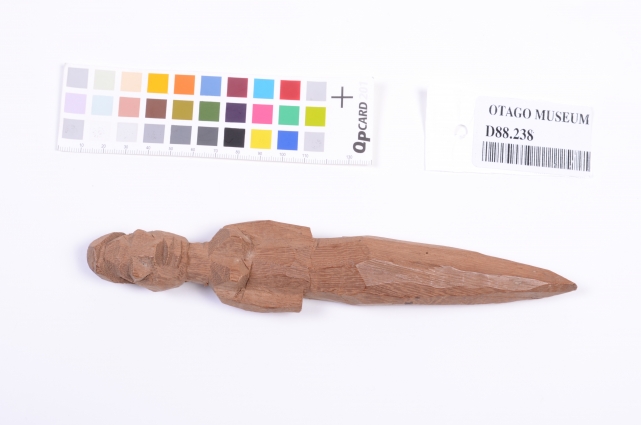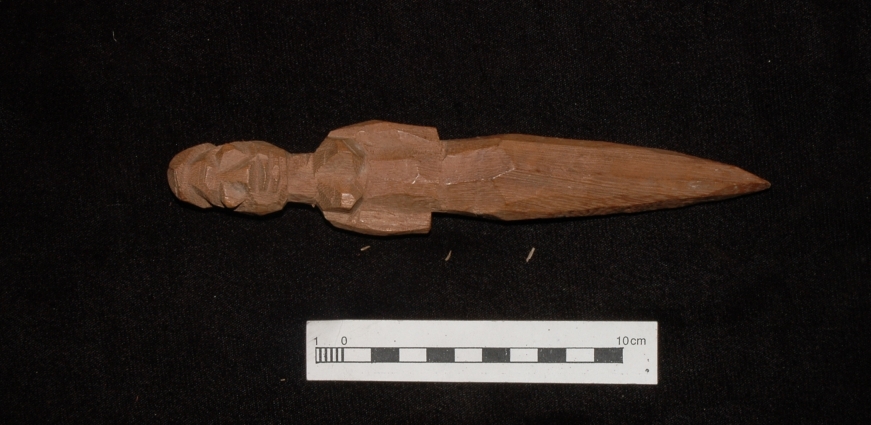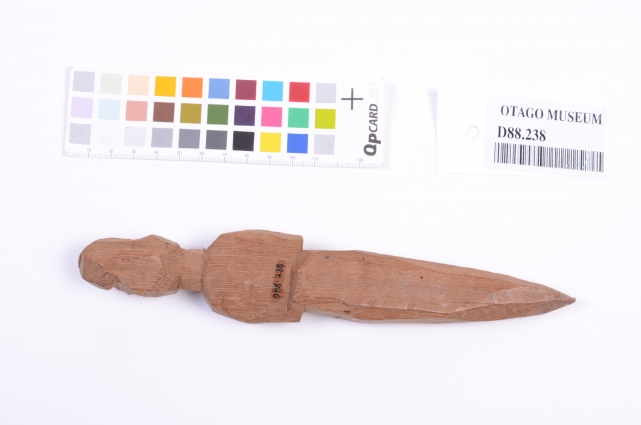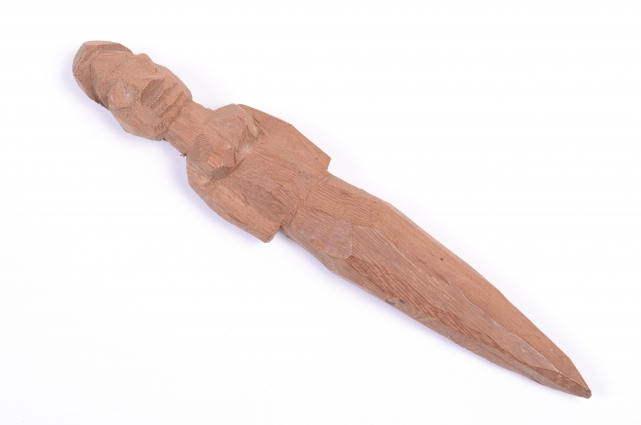Figure, D88.238
Physical Description
Wooden carved dagger?. Hard, red wood. Appears to be unfinished. Long body, pointed at the base, very thick that is why it appears unfinished. Short arms attached to body no hands. Small breasts. Narrow, long head, stylized face, with large eyes. Small, dome - like hair.
Research Notes
Possibly akin to Yoruba but as found in Fon people/culture of Benin (formerly Dahomey).
Benin (formerly Dahomey) West Africa. Original documentation suggests was collected in near Accra, in Ghana. If so was likely purchased from itinerant trader who had acquired it from Benin (Dahomey).
Light coloured wood.
A bocio is a figure meant to protect a family or individual from both evil spirits and the more earthly misfortunes of illness and theft. Bocio act as an intermediary between humans and the gods. They are usually placed in rooms acting as family shrines. Long, narrow, light coloured wood figure/female with sharp angular breasts. Arms extended rigidly to sides with no hands/fingers. Short neck with roughly carved face, protruding eyes not unlike 'Yoruba' carvings of Nigeria (and into Benin (Dahomey.) Apparent upper hairpiece is possibly a scarf, i.e. a head wrap as worn by women of this area. From the stomach on down the form is that of a round dagger. Likely this is the intended final shape, and is stuck into the ground as in a shrine. Figure appears to be unused but is consistent with traditional carvings of this area. Quite possibly this was not originally intended as tourist art. General appearance is that of rather roughly carved figure, unused, and in good condition. (Note: insect holes in lower half.)
1950s?
Height = approx. 212mm. Diameter at waist (from front left to right) = approx. 25.7mm.
Bocio(?)
Benin (formerly Dahomey) West Africa. Original documentation suggests was collected in near Accra, in Ghana. If so was likely purchased from itinerant trader who had acquired it from Benin (Dahomey).
Light coloured wood.
A bocio is a figure meant to protect a family or individual from both evil spirits and the more earthly misfortunes of illness and theft. Bocio act as an intermediary between humans and the gods. They are usually placed in rooms acting as family shrines. Long, narrow, light coloured wood figure/female with sharp angular breasts. Arms extended rigidly to sides with no hands/fingers. Short neck with roughly carved face, protruding eyes not unlike 'Yoruba' carvings of Nigeria (and into Benin (Dahomey.) Apparent upper hairpiece is possibly a scarf, i.e. a head wrap as worn by women of this area. From the stomach on down the form is that of a round dagger. Likely this is the intended final shape, and is stuck into the ground as in a shrine. Figure appears to be unused but is consistent with traditional carvings of this area. Quite possibly this was not originally intended as tourist art. General appearance is that of rather roughly carved figure, unused, and in good condition. (Note: insect holes in lower half.)
1950s?
Height = approx. 212mm. Diameter at waist (from front left to right) = approx. 25.7mm.
Bocio(?)
Provenance
Locality:
Accra
?Locality, according to Joel Vanderburg:
Benin
Measurements
Maximum dimensions (H x W x D): 215 x 40 x 25mmAll Rights Reserved








